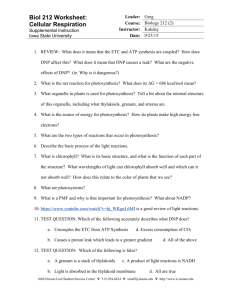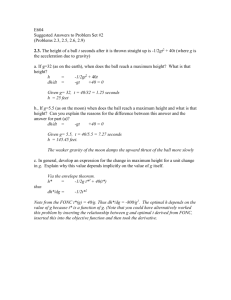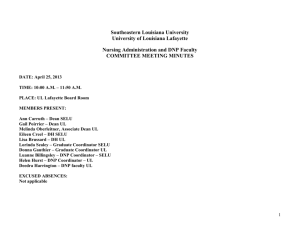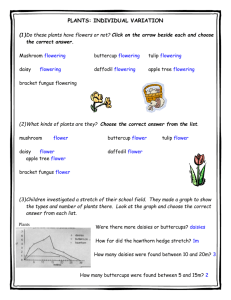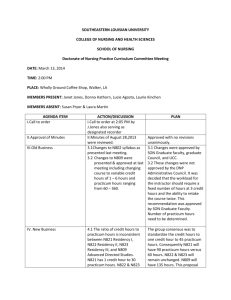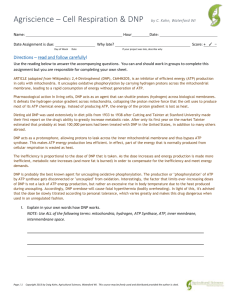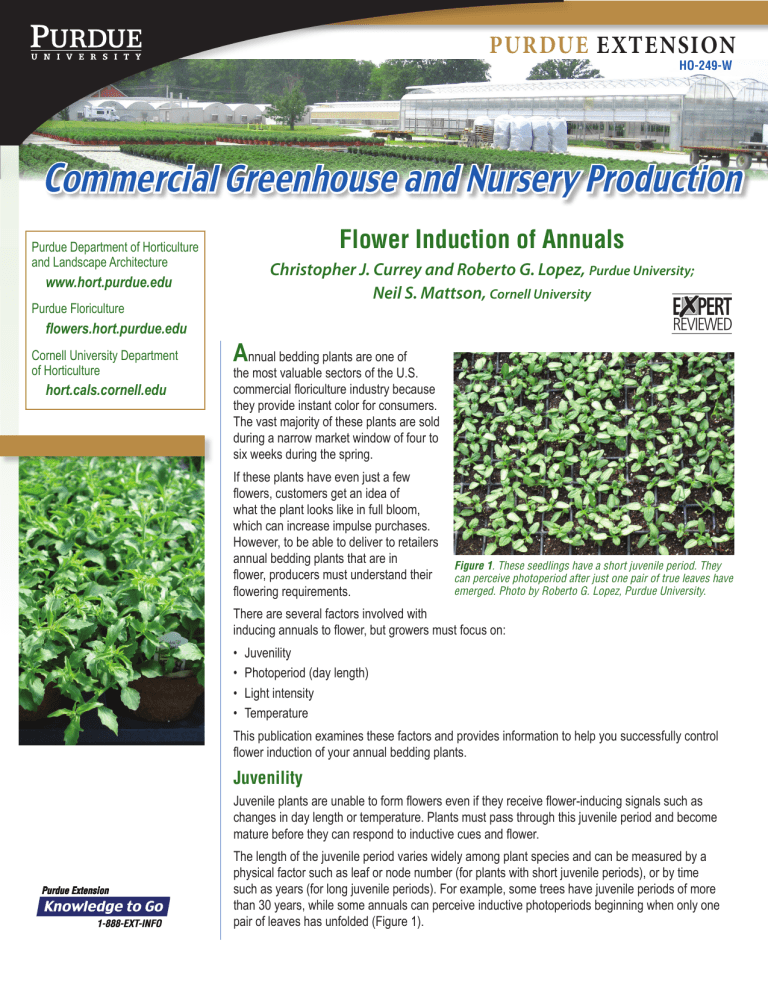
Purdue Extension
HO-249-W
Commercial Greenhouse and Nursery Production
Flower Induction of Annuals
Purdue Department of Horticulture
and Landscape Architecture
Christopher J. Currey and Roberto G. Lopez, Purdue University;
Neil S. Mattson, Cornell University
www.hort.purdue.edu
Purdue Floriculture
flowers.hort.purdue.edu
Cornell University Department
of Horticulture
hort.cals.cornell.edu
A
nnual bedding plants are one of
the most valuable sectors of the U.S.
commercial floriculture industry because
they provide instant color for consumers.
The vast majority of these plants are sold
during a narrow market window of four to
six weeks during the spring.
If these plants have even just a few
flowers, customers get an idea of
what the plant looks like in full bloom,
which can increase impulse purchases.
However, to be able to deliver to retailers
annual bedding plants that are in
flower, producers must understand their
flowering requirements.
Figure 1. These seedlings have a short juvenile period. They
can perceive photoperiod after just one pair of true leaves have
emerged. Photo by Roberto G. Lopez, Purdue University.
There are several factors involved with
inducing annuals to flower, but growers must focus on:
•
•
•
•
Juvenility
Photoperiod (day length)
Light intensity
Temperature
This publication examines these factors and provides information to help you successfully control
flower induction of your annual bedding plants.
Juvenility
Juvenile plants are unable to form flowers even if they receive flower-inducing signals such as
changes in day length or temperature. Plants must pass through this juvenile period and become
mature before they can respond to inductive cues and flower.
The length of the juvenile period varies widely among plant species and can be measured by a
physical factor such as leaf or node number (for plants with short juvenile periods), or by time
such as years (for long juvenile periods). For example, some trees have juvenile periods of more
than 30 years, while some annuals can perceive inductive photoperiods beginning when only one
pair of leaves has unfolded (Figure 1).
HO-249-W
2
Flower Induction of Annuals
How does juvenility affect the flowering of annuals?
Many bedding plants are propagated by seeds and
producers commonly receive seedlings in plug trays.
When you order plugs it is not the size of the plug
itself that determines juvenility, but the developmental
age of the seedling.
Purdue Extension
Photoperiod (Day Length)
Flowering responses are described based on the
response to the length of the day (even though
research demonstrates that the real inductive signal
is the length of night).
As a grower, you should be familiar with several
concepts related to photoperiodic flower induction,
including: photoperiodic response groups, critical
day length, and inductive cycle number.
Photoperiodic Response Groups
Plants are divided into three main categories (photoperiodic response groups) based on when they
flower:
Figure 2. Cosmos is a short-day plant. The plants on the
left were grown under a long-day photoperiod created
by night interruption lighting. The plants on the right
were grown on a short-day photoperiod created by black
cloth. Photo provided by Ryan Warner, Michigan State
University.
For example, a seedling grown in a 512-cell plug tray
is typically sold at an earlier developmental age than
a seedling in a 128-plug tray. This is because the
seedlings required fewer leaves (less plant development) to fill in the 512-cell tray than the seedlings
in the 128-cell tray. Consequently, the seedlings in
the 128-cell tray are more mature than seedlings in
the 512-cell tray. Once transplanted, seedlings from
the 512-cell tray may outgrow the juvenile stage and
flower induction may take place.
Although many bedding plants are propagated from
seed, popularity is growing for varieties and species
that are propagated by cuttings. Juvenility does not
apply to vegetatively propagated crops. Cuttings
harvested from stock plant tissue are already mature
and capable of responding to inductive conditions
immediately.
Vegetative cuttings are produced by maintaining
stock plants under noninductive photoperiods, pinching terminal buds, and applying ethephon (Florel®).
However, since cuttings come from mature (nonjuvenile) mother plants, they are capable of being
induced to flower.
• Short-day plants (SDP), which flower when the
day length is at or shorter than a certain time.
Technically, because plants are actually responding to night length, short-day plants flower in
response to a long night length (Figure 2).
• Long-day plants (LDP), which flower when the
day length is at or longer than a certain time.
• Day-neutral plants (DNP), which flower regardless of the day length.
Furthermore, LDP and SDP responses may be
further classified as either obligate or facultative.
Plants with an obligate photoperiod response must
be exposed to short or long photoperiods to flower or
will remain vegetative.
Alternatively, plants with a facultative photoperiod
response will flower more quickly when exposed to
inductive long days (LD) or short days (SD) — flowering will eventually occur regardless of day length.
Table 1 lists the photoperiodic response groups of
many common bedding plant species.
Critical Day Length
How do you know how “long” or “short” a day needs
to be to induce flowering?
The specific day length that a plant requires to flower
can be called the critical daylength (CDL). Broadly
defined, CDL is the length of the photoperiod at
which flowering occurs.
CDL can vary among photoperiodic species. Florist
(potted) chrysanthemums (an SDP) have a CDL of
around 14 hours, and flowering occurs when the
photoperiod is 14 hours or shorter. In the case of
garden chrysanthemums, some cultivars flower
HO-249-W
3
Purdue Extension
Flower Induction of Annuals
earlier in the fall (early-season
chrysanthemums) than others
(late-season chrysanthemums).
Early-season chrysanthemums
have longer CDLs, which is why
they flower earlier in the summer
than their late-season counterparts.
One way to create SD photoperiods is to truncate the day length
by pulling blackcloth over plants
in the late afternoon or evening
and retracting it in the morning to
create the desired photoperiod.
Figure 3. The cosmos shown here received 0, 5, 10, 15, 20, 25, or 30
inductive short days before being placed under noninductive long days.
Photo provided by Ryan Warner, Michigan State University.
A way to create LD photoperiods
is to use day-extension (DE) or night-interruption
(NI) lighting. With DE lighting, you turn on a light
source (such as high-pressure sodium (HPS) or
incandescent lamps) before the sun sets, and keep
them on until you achieve the desired day length.
With NI lighting, you use some type of light to
“interrupt” the dark period in the middle of the night —
traditionally by using incandescent lamps to provide
~2 µmol·m-2·s-1 (10 foot-candles) from 10 p.m. to 2
a.m. By interrupting the dark period, plants perceive a
short night length and, therefore, an LD photoperiod.
Inductive Cycle Number
When you are inducing plants to flower, each 24-hour
period is referred to as an inductive cycle. Plants
must be exposed to a minimum number of inductive
cycles to induce a flowering response. The critical
cycle number (CCN) is the minimum number of
inductive cycles a plant must experience to ensure
flowering will occur even if plants are placed under
noninductive photoperiods (Figure 3).
You can regulate plant height by limiting how much
exposure LD annuals have to inductive photoperiods
by using a technique called limited inductive photoperiod treatment (LIP). To do this, expose plants to
LD photoperiods for the CCN, and then expose them
to SD photoperiods. The result is plants that are in
flower, but have limited stem elongation.
However, using LIP is not ideal for every crop. For
example, ‘Classic Liberty Bronze’ snapdragons
(Antirrhinum majus) grown under continuous LD
flowered quicker than plants exposed to less than
30 LDs.
To maximize your success with photoperiodic annuals, it is best to try and familiarize yourself with
the photoperiodic response group, CDL, and CCN
requirements for the annuals you are producing.
Light Intensity
The total amount of photosynthetic light a plant
receives throughout the day — called the daily light
integral (DLI) — can affect plant attributes, including
crop timing and quality.
DLI and Growth
The time to flower decreases under light limiting
conditions when DLI is limiting (< 12 mol·m-2·d-1), as
the DLI increases overall plant mass and number
of flowers and branches increase, and in certain
crops. The increased crop quality is due to increased
plant photosynthesis in response to the increased
DLI. It may also be due to changes in plant habit. A
plant receiving high light may develop more lateral
branches and thus have more leaves to capture
light. Additionally, crop time is usually reduced when
supplemental lights such as HPS lamps are used.
This is because the energy from the lamps increases
plant temperature, thus increasing plant developmental rates.
More information about DLI is available in
Commercial Greenhouse and Nursery Production:
Measuring Daily Light Integral in a Greenhouse
(Purdue Extension publication HO-238-W), available
from the Purdue Extension Education Store, www.the-education-store.com.
Irradiance Response
DLI affects overall crop quality and production
time, but it has other effects, too. As DLI increases,
the amount of time a plant needs to flower may
be reduced. That’s because the number of leaves
HO-249-W
4
Flower Induction of Annuals
unfolded below the first flower have been reduced (in
other words, increased DLI may induce flowering at
an earlier developmental state than normal). This is
called a facultative irradiance (FI) response.
Alternatively, an irradiance indifferent (II) response is
when increasing DLI has no effect on the number of
leaves below the first flower or on time to flower.
For example, research has shown that when ‘Rose
Queen’ cleome (Cleome hasslerana) received 1,145
foot candles (150 µmol·m-2·d-1) of supplemental
light, the number of leaves below the first flower
decreased by eight, and time to flowering decreased
by 37 days compared to plants grown under ambient
light — these plants demonstrated an FI response.
When desert bells (Phacelia campanularia) received
the same supplemental light, leaf number and time
to flowering were the same as plants under ambient
light — these plants demonstrated an II response.
Table 1 lists the irradiance response groups of many
common bedding plant species.
Temperature
To produce the highest quality flowering plants, it is
important to understand how each plant responds to
temperature. In addition to the general effect of the
average daily temperature (ADT) on plant development, annuals may be sensitive to temperature
extremes.
Temperature and Development
A plant’s development rate is primarily a function
of the average daily greenhouse temperature.
Generally, within a range of ADT from 45ºF to 85ºF
production time increases or decreases as the ADT
decreases or increases, respectively.
Temperature Sensitivity
High night temperatures can delay flowering, a
disorder called “heat delay.” This disorder is common
with potted crops such as poinsettia (Euphorbia pulcherrima) and kalanchoe (Kalanchoe blossfeldiana),
but it can affect some annuals including gomphrena
(Gomphrena globosa) and New Guinea impatiens
(Impatiens hawkeri).
Lastly, some annuals are sensitive to the ADT,
regardless of the nighttime or daytime temperatures.
This response is common in zonal geraniums
(Pelargonium × hortorum), which produce fewer
flowers as the ADT increases from 50°F to 86°F.
Purdue Extension
Table 1 outlines ideal production temperatures for
many common bedding plant species.
Bringing It All Together
So how can you put together all of this information to
help you get your annuals in flower on time?
First, sit down and put together a production schedule. Start with your target sales date. Next, identify if
the species you are scheduling has a photoperiodic
response.
Let’s say you want a crop in flower for Week 22, it
is an SDP, and it flowers about five weeks after the
start of SD. To get plants flowering by the target
sales date, you should start SDs during Week 17.
Alternatively, if you are trying to bulk up plants so
they will fill in larger containers, you don’t want to
grow them under inductive photoperiods that result
in flowering too soon after planting.
Alternatively, consider a seed-propagated petunia
(Petunia ×hybrida) crop in 5-inch pots. Since most
seed petunias are LDPs, you’ll want to keep plants
under SD conditions for a few weeks after transplanting to promote vegetative growth and inhibit
flowering. After the plants reach a certain size, you
can place them under LD conditions to promote
flowering.
If you are unsure about the photoperiodic or irradiance responses of an annual you are growing, try
some small-scale tests to learn about the responses.
For example, put a few plants under blackcloth and
a few under NI lighting and see how they respond.
Similarly, grow some plants with and without supplemental light to see how they respond to the differences in light.
HO-249-W
5
Purdue Extension
Flower Induction of Annuals
Table 1. Photoperiod responses, irradiance responses, and temperature groups for numerous bedding and perennial plants.
Photoperiod
Response1
Irradiance
Response2
Temperature
Group3
Scientific Name
Common Name
Abutilon × hybridum
flowering maple
DNP
—
—
Achimines hybrids
achimenes
DNP
—
—
Acroclinium roseum
strawflower
OLDP
II
—
FLDP
—
2
FLDP
II
2
FLDP
—
2
Ageratum houstonianum
A. houstonianum ‘Blue Danube’
flossflower
A. houstonianum ‘Tall Blue Horizon’
Alcea rosea
hollyhock
LDP
—
2
Amaranthus hybridus ‘Pygmy Torch’
smooth amaranth
DNP
II
2
Ammi majus
bishop’s weed
OLDP
II
1-2
Angelonia angustifolia
summer
snapdragon
DNP
—
—
OLDP
II
1
OLDP
II
1
FLDP
—
—
Anethum graveolens
A. graveolens ‘Mammoth’
Anisodontea × hypomandarum
dill
cape mallow
Antirrhinum majus
A. majus ‘Floral Showers Crimson’
snapdragon
A. majus ‘Spring Giants’
FLDP
FI
1-2
FLDP
—
1-2
FLDP
—
1-2
Argyranthemum frutescens
marguerite daisy
DNP
Asclepias curassavica
Mexican butterfly
weed
DNP
FI
2
butterfly weed
OLDP
—
2
Asperula arvensis ‘Blue Mist’
blue woodruff
OLDP
II
—
Begonia × hiemalis
rieger begonia
O/FSDP
—
2
A. tuberosa
—
—
2
FI
2
FI
—
B. tuberhybrida
tuberous begonia
OLDP
B. semperflorens
wax begonia
DNP
Bougainvillea spp.
paper flower
FSDP
Bracteantha bracteata
strawflower
DNP
—
—
Calceolaria herbeohybrida
pocketbook plant
FLDP
—
—
O/FLDP
—
1
FLDP
II
1
FLDP
—
—
FLDP
—
—
Calendula officinalis
C. officinalis ‘Calypso Orange’
Calibrachoa ‘Colorburst Violet’
C. ‘Liricashowers Rose’
pot marigold
million bells
Callistephus chinensis
China aster
FLDP
—
1
Capsicum annuum
pepper
DNP
—
2
Carpanthea pomeridiana ‘Golden Carpet’
golden carpet
DNP
II
—
Catanache caerulea ‘Blue’
Cupid’s dart
OLDP
FI
1-2
Catharanthus roseus
vinca
DNP
—
3
FSDP
—
2
OSDP
II
2
Celosia argentea
C. plumosa ‘Flamingo Feather Purple’
cockscomb
HO-249-W
6
Purdue Extension
Flower Induction of Annuals
Table 1. (continued)
Scientific Name
Centaurea spp.
C. cyanus ‘Blue Boy’
Centranthus macrosiphon
Common Name
bachelor’s buttons
spurred valerian
Cleome hassleriana
C. hassleriana ‘Pink Queen’
spider flower
Photoperiod
Response1
Irradiance
Response2
Temperature
Group3
O/FLDP
—
1
OLDP
II
1
DNP
FI
1-2
DNP/OLDP
—
3
FLDP
II
3
DNP
FI
3
spiny spider flower
FSDP
—
3
bleeding heart vine
DNP
—
—
red bleeding heart
vine
DNP
—
—
Cobaea scandens
cup and saucer vine
DNP
II
1
Convulvulus tricolor ‘Blue Enchantment’
morning glory
DNP
FI
2
Cosmos astrosanguineus
chocolate cosmos
FLDP
—
2
FSDP
II
2
Mexican aster
FSDP
—
2
FSDP
FI
2
C. sulphureus
yellow cosmos
OSDP
—
2
Collinsia heterophylla
Chinese houses
FLDP
II
—
Crossandra infundibuliformis
firecracker flower
DNP
—
—
Cucumis sativus
cucumber
DNP
—
1-2
Dahlia × hybrida
dahlia
FSDP
—
1-2
Dendranthema × grandiflorum
chrysanthemum
FSDP
—
2
Dianthus barbatus
sweet William
DNP
—
1-2
pinks
FLDP
II
1
diascia
DNP
—
—
DNP
II
2
C. hassleriana ‘Rose Queen’
C. spinosa
Clerodendrum thomsoniae
C. × speciosum
C. bipinnatus ‘Daiblo’
C. bipinnatus ‘Early Wonder’’
C. bipinnatus ‘Sensation White’
D. chinensis ‘Ideal Cherry Purple’
Diascia hybrids
Dimorphoteca aurantica ‘Mixed Colors’
D. aurantica ‘Salmon Queen’
Cape marigold
OLDP
—
2
Dolichos lablab
hyacinth bean
OSDP
II
2
Eschscholzia californica
California poppy
FLDP
II
1
Evolvulus glomeratus
evolvulus
LDP
—
—
Exacum affine
Persian violet
DNP
—
—
OLDP
—
—
Fuschia × hybrida
F. ‘Gartenmeister’
Gallardia × grandiflora
G. × grandiflora ‘Goblin’
hybrid fuschia
blanketflower
DNP
—
—
FLDP
—
2
OLDP
—
2
Gazania rigens ‘Daybreak Red Stripe’
treasure flower
OLDP
FI
2
Gerbera jamesonii
gerbera daisy
FSDP
—
2-3
Gomphrena globosa ‘Bicolor Rose’
globe amaranth
Gypsophilia elegans
G. paniculata
baby’s breath
G. paniculata ‘Snowflake’
Helianthus annuus
sunflower
FSDP
II
3
F/OLDP
—
1
F/OLDP
—
1
OLDP
—
1
DNP/FSDP
—
1
HO-249-W
7
Purdue Extension
Flower Induction of Annuals
Table 1. (continued)
Scientific Name
Common Name
Photoperiod
Response1
Irradiance
Response2
Temperature
Group3
H. annuus ‘Big Smile’
FSDP
—
1
H. annuus ‘Elf’
FSDP
—
1
H. annuus ‘Pacino’
FSDP
—
1
FSDP
—
1
H. annuus ‘Sunbright’
H. annuus ‘Sundance Kid’
sunflower
(continued)
DNP
—
1
FSDP
—
1
H. annuus ‘Sunspot’
FSDP
—
1
H. annuus ‘Teddy Bear’
FSDP
—
1
H. debilis ‘Vanilla Ice’
FLDP
II
1
DNP
—
2-3
H. annuus ‘Sunrich Orange’
Hibiscus cisplatinus
H. laevis
halberd-leaf
rosemallow
OLDP
—
2-3
H. moscheutos
swamp mallow
OLDP
FI
2-3
H. radiatus
monarch
rosemallow
OSDP
—
2-3
H. rosa-sinensis
Chinese hibiscus
DNP
—
2-3
H. trionum
flower-of-an-hour
FLDP
—
2-3
garden balsam
OSDP
—
2
I. hawkeri
New Guinea
impatiens
DNP
—
2-3
I. wallerana
busy lizzy
Impatiens balsamina
Ipomoea × multifida ‘Scarlet’
I. spp.
cardinal climber
DNP
—
2
FSDP
II
2-3
FSDP
—
—
Ipomopsis rubra ‘Hummingbird Mix’
standing cypress
OLDP
II
—
Jamesbrittania hybrids
bacopa
DNP
—
—
Lanatana camara
L. montevidensis
shrub verbena
DNP
—
—
DNP
—
—
Lathyrus odoratus ‘Royal White’
sweet pea
OLDP
FI
1
Lavatera trimestris ‘Silver Cup’
annual mallow
OLDP
FI
1-2
Legousia speculum-veneris
Venus’ looking glass
OLDP
II
—
Leonotis menthaefolia
mint scented lion’s
tail
DNP
—
—
OLDP
II
—
Leptosiphon hybrida
Lilium spp.
lily
FLDP
—
—
Limnanthes douglasii
poached egg plant
OLDP
FI
—
FLDP
II
2
Limonium sinuata ‘Fortress Deep Rose’
L. sinuata ‘Heavenly Blue’
statice
FLDP
II
2
Linaria maroccana
toadflax
FLDP
FI
—
Linum perenne
blue flax
OLDP
FI
1-2
OLDP
—
2
OLDP
II
2
FLDP
—
2
FLDP
—
2
Lobelia erinus
L. erinus ‘Crystal Palace’
L. × speciosa
L. × speciosa ‘Compliment Scarlet’
trailing lobelia
HO-249-W
8
Purdue Extension
Flower Induction of Annuals
Table 1. (continued)
Photoperiod
Response1
Irradiance
Response2
Temperature
Group3
Scientific Name
Common Name
Lobularia maritima
sweet alyssum
DNP
—
1-2
Lycopersicon esculentum
tomato
DNP
—
2
Matthiola hybrids
stock
FLDP
—
1
evening stock
DNP
II
1
Mimulus × hybridus ‘Magic’
M. longipetala ‘Straight Sensation’
monkeyflower
OLDP
II
1
Mina lobata
Spanish flag
OSDP
II
—
Mirabilis jalapa
four o’clock flower
OLDP
II
2
Nemophila maculata ‘Pennie Black’
five-spot
DNP
FI
3
baby blue eyes
DNP
II
3
DN/FLDP
—
2
DNP
FI
1
N. menziesii
Nicotiana alata
N. alata ‘Domino White’
flowering tobacco
Nigella damascena ‘Miss Jekyll’
love-in-a-mist
OLDP
II
1
Ocimum basilicum
basil
FSDP
—
2
Oenethera pallida ‘Wedding Bells’
pale evening
primrose
OLDP
II
1
Origanum vulgare
oregano
DNP
FI
1
Osteospermum hybrids
African daisy
FLDP
—
—
Oxypetalum caerulea ‘Blue Star’
tweedia
DNP
FI
2
Pelargonium × domesticum
regal geranium
FLDP
—
—
P. × hortorum
zonal geranium
DNP
FI
—
P. peltatum
ivy geranium
DNP
—
—
FLDP/DNP
—
—
?SDP
—
2
FSD/OLDP
—
2
P. × hybrida ‘Cascadia Charme’
FSDP
—
2
P. × hybrida ‘Cascadia Improved Charlie’
FLDP
—
2
P. × hybrida ‘Doubloon Blue Star’
FLDP
—
2
OLDP
—
2
P. × hybrida ‘Marco Polo’
FLDP
—
2
P. × hybrida ‘Petitunia Bright Dream’
FLDP
—
2
P. × hybrida ‘Purple Wave’
OLDP
FI
2
P. × hybrida ‘White Storm’
FLDP
—
2
Pentas lanceolata
Egyptian starflower
Perilla frutescens
green shiso
Petunia × hybrida
P. × hybrida ‘Fantasy Pink Morn’
petunia
Phacelia campanularia
desert bells
DNP
II
—
P. tanacetifolia
lacy phacelia
FLDP
II
—
Pharbitis nil
morning glory
FSDP
—
1-2
Phlox chinensis
annual phlox
FLDP
—
1
Polemonium viscosum
sky pilot
OLDP
II
—
Portulaca grandiflora
moss rose
DNP
—
2
P. oleracea
flowering purslane
DNP
—
—
Primula malacoides
fairy primrose
OSDP
—
1
P. obconica
German primrose
DNP
—
1
P. × polyantha
English primrose
DNP
FI
1
HO-249-W
9
Purdue Extension
Flower Induction of Annuals
Table 1. (continued)
Photoperiod
Response1
Irradiance
Response2
Temperature
Group3
Scientific Name
Common Name
Rosa × hybrida
rose
DNP
FI
—
Rudbeckia spp.
black-eyed Susan
OLDP
—
1
Salpiglossus sinuata
painted tongue
FLDP
—
1
Salvia farinacea
mealy sage
FLDP
FI
2-3
scarlet sage
FLDP
II
2
Sanvitalia procumbens
Mexican creeping
zinnia
FSDP
II
2
Scabiosa columbaria
pincushion flower
?DNP
—
1-2
Scaevola aemula
fan flower
DNP
—
—
Silene armeria ‘Elektra’
catchfly
OLDP
FI
—
Sinningia speciosa
gloxinia
DNP
—
—
Solenostemon spp.
coleus
?SDP
—
3
Solidago spp.
goldenrod
SDP
—
—
Sutera cordata
bacopa
DNP
—
—
Streptocarpus × hybridus
Cape primrose
DNP
FI
—
Tagetes erecta
African marigold
FSDP
—
2
T. patula
French marigold
DNP
—
2
T. tenuifolia
signet marigold
FSDP
—
2
black-eyed Susan
vine
DNP
II
2
FLD/FSDP
—
2
FLDP
II
2
FSDP
FI
2
S. splendens ‘Vista Red’
Thunbergia alata
Tithonia rotundifolia
T. rotundifolia ‘Fiesta Del Sol’
Mexican sunflower
T. rotundifolia ‘Sundance’
Torenia fournieri
wishbone flower
?DNP
—
2-3
Verbascum phoeniceum
mullein
DNP
II
1
Verbena × hybrida
verbena
?LDP
—
2
Viguiera multiflora
goldeneye
FLDP
II
—
Viola tricolor
violet
F/OLDP
II
1
pansy
FLDP
FI
1
creeping zinnia
DNP
—
2-3
FLDP
—
2
FSDP
II
2
FSDP
—
2
FSDP
II
2
V. × wittrockiana
Zinnia angustifolia
Z. elegans ‘Benary Giant Deep Red’
Z. elegans ‘Exquisite Pink’
Z. elegans ‘Oklahoma’
Z. elegans ‘Peter Pan Scarlet’
zinnia
Source: Table material adapted from A.M. Armitage (1994, Growing-on), M. Karlsson and R. Larson. (1994, Light, Temperature, and
Carbon Dioxide), J.E Erwin and R.M. Warner (1999, Temperature), W.H. Carlson, M.P. Kaczperski, and E.M. Rowley (1993, Bedding
Plants), J. Erwin, N. Mattson, and R. Warner (2004, Light Effects on Annual Bedding Plants).
1
SD=short-day photoperiodic response. LD=long-day photoperiodic response. F=facultative response. O=obligate responses. ? =F or O
response unknown.
2
FI=facultative irradiance response. II=irradiance indifferent response. — = response unknown.
Ideal temperature ranges. 1=55-65°F. 2=63-68°F. 3=65-75°F. — = data not available. Other factors (such as light levels, time of year,
location, and energy consumption) should be taken into consideration.
3
HO-249-W
10
Purdue Extension
Flower Induction of Annuals
References
Armitage, A.M. 1994. Growing-on. In: Ornamental Bedding Plants. CAB International, Wallingford,
United Kingdom.
Carlson, W.H., M.P. Kaczperski, and E.M. Rowley. 1993. Bedding Plants. In: Larson, R. (ed.).
Introduction to Floriculture, 2nd ed. Academic Press, Orlando, FL.
Dole, J.M., and H.F. Wilkins. 2005. Flowering Control. In: Floriculture: Principles and Species.
Pearson Prentice Hall, Upper Saddle River, NJ.
Erwin, J.E. 2007. Factors Affecting Flowering in Ornamental Plants. In: Anderson, N.O. (ed.).
Flower Breeding and Genetics: Issues, Challenges and Opportunities for the 21st Century.
Springer, Dordrecht, The Netherlands.
Erwin, J., N. Mattson, and R. Warner. 2004. Light Effects on Annual Bedding Plants. In: Fisher, P.,
and E. Runkle. (eds.). Lighting Up Profits: Understanding Greenhouse Lighting. Meister Media
Worldwide, Willoughby, OH.
Erwin, J.E. and R.M. Warner. Temperature. In: Gaston, M.L., C.A. Buck, S.A. Carver, P.S.
Konjoian, L.A. Kunkle and M.F. Wilt (eds.). Tips on Growing Bedding Plants, 4th ed. O.F.A.
Services, Inc. Columbus, OH.
Karlsson, M., and R. Larson. 1994. Light, Temperature, and Carbon Dioxide. In: Holcomb, E.J.
(ed.). Bedding Plants IV. Ball Publishing, Batavia, IL.
Warner, R.M. Reducing Crop Production Time of Photoperiodic Annual Bedding Plants. 13 August
2010. www.hrt.msu.edu/energy/Notebook/pdf/Sec1/Reducing_Crop_Production_Time_of_
Photoperiodic_Annuals_by_Warner.pdf.
To see other publications in this series, visit
the Purdue Extension Education Store, www.the-education-store.com.
Reference to products in this publication is not
intended to be an endorsement to the exclusion
of others which may be similar. Persons using
such products assume responsibility for their
use in accordance with current directions of the
manufacturer.
Purdue Agriculture
6/11
It is the policy of the Purdue University Cooperative Extension Service that all persons have equal opportunity and access to its educational programs, services, activities, and
facilities without regard to race, religion, color, sex, age, national origin or ancestry, marital status, parental status, sexual orientation, disability or status as a veteran.
Purdue University is an Affirmative Action institution. This material may be available in alternative formats.
1-888-EXT-INFO
http://www.the-education-store.com

